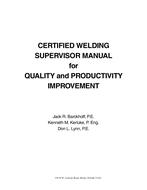Aws Visual Inspection Workshop Reference Manual
INTRODUCTION Rationale Inspection is traditionally considered a post-processing activity. A machine component may be turned to finished form and size—then inspected for conformance to the applicable drawing or specification. A garment is inspected after sewing and all the buttons and other features are in place. In these and similar instances, visual inspection is carried out after the production activities have been completed.


Aws Customer References
In the case of weldments, experience has shown that post-processing inspection, even when supplemented with nondestructive examination (NDE), gives no guarantee of suitability for intended service. However, consistent results over a considerable period of time have demonstrated the effectiveness of a preplanned sequence of visual inspections. If carried out at specific stages of weldment production, such programs give a high degree of assurance of meeting quality expectations—frequently without recourse to NDE. With welding, the factors influencing quality may manifest themselves at any stage of the production operation. In many instances, quality is compromised even before welding commences. In most such circumstances, suitably timed visual inspection would have revealed the shortcoming at a stage when corrective action would be simple to implement and inexpensive to carry out.
Weld and weldment quality are determined by:. Weldment and joint design. Materials used in construction.
Welding procedures. Manner of weld application.

Inspection program Visual welding inspection provides the basis for the effective control of these determinants.